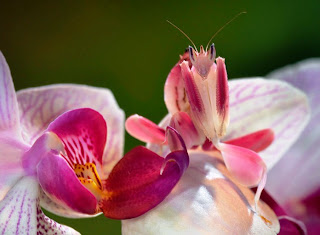We've known that some orchid mimicking certain types of insect as a part of pollination strategy. But this time its reversed..an insect mimicking orchids to find prey. The insect known as Orchid Mantis a unique and perfectly camouflaged in its surrounding..at the same time the mantis predators such as bats, toads or birds were also deceived..so its safe from being eaten..I've seen the live ones in Penang Butterfly farm quite a long time ago..
Here's some info..
Hymenopus coronatus (known by a variety of common names including Malaysian orchid mantis, Malaysian orchid praying mantis, pink orchid mantis and orchid mantis) is a mantis from Malaysia, Indonesian, and Sumatran rain forests. These mantises thrive in humid, warm areas of south Asian rain forests. These mantids can be found on papaya trees, orchids, or frangipani trees with flowers. In captivity, the nymph's diet can consist mainly of fruit flies, but they will eat other small insects. Adults will eat anything they can catch; this includes small lizards, bees without stingers, house flies, butterflies, moths and other non-venomous flying insects. Although primarily carnivorous, orchid mantises have been observed eating little bits of banana, this behavior is thought to balance the mantis's vitamin intake through the juices of the banana (which are rich in potassium).
This species is characterized by brilliant and beautiful coloring and unusual structure; their four walking legs resemble flower petals, and the coloration of the bodies tends to match the environment in which they were raised. Young nymphs resemble ants with orange and black bodies. As the mantis grows in its environment, its color comes to more closely match the coloration of its surroundings with each passing molt. It has been theorized that humidity and intensity of light play a large role in the final coloration of the adult.
Source wikipedia
Portrait of an Orchid Mantis..pose fotogenik ni..!
Eh...salah bunga daa...
Makan apa tu bang ..?
Can you spot me..? Cari mentadak tersembunyi..
Sedang menunggu mangsa di atas bunga Phalaenopsis..
The Orchid Mantis is an rare insect that can be found only white or purplish/pinkish white flowers
The orchid mantis from Indonesia and Malaysia, Hymenopus coronatus, is one of the most beautiful insect in the world and a symbol of complex and perfect camouflage in animal kingdom
Orchid mantis in action..!
Orchid mantis in action..!
"The orchid mantis has the awful habit of disquising itself as a flower in order to avoid its enemies. ...I say "awful" because of how revolting it is to touch a flower and feel the belly of a mantis! Oh, it was so soft and vile! Blech! The memories! I try to suppress them, but they always come flooding back!"
Blathers, museum curator











Thanks for the info tuan.
ReplyDeleteMy pleasure..
ReplyDeleteWhat an amazing creature and your photographs are beautiful!
ReplyDelete